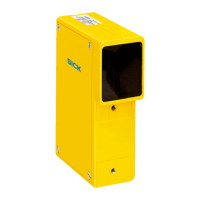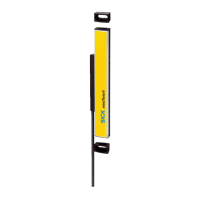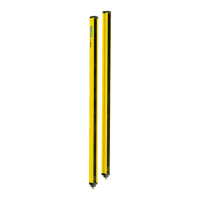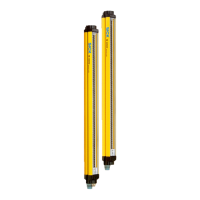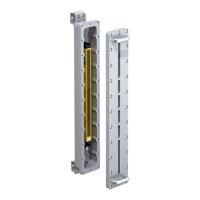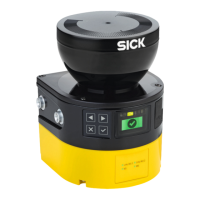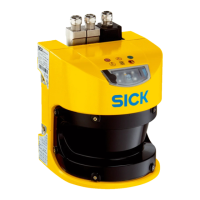
Do you have a question about the SICK nanoScan3 I/O and is the answer not in the manual?
| Scanning range | 3 m |
|---|---|
| Protective field range | 3 m |
| Number of field sets | 128 |
| Number of simultaneously monitored protective fields | up to 4 |
| Scanning angle | 275° |
| Enclosure rating | IP65 |
| Operating temperature | -10 °C to +50 °C |
| Protective field resolution | 70 mm |
| Number of protective fields | 128 |
| Operating voltage | 24 V DC |
| Protection rating | IP65 |
| Supply voltage | 24 V DC |
| Power consumption | 8 W |
| Interfaces | Ethernet |
| Safety integrity level | SIL2 (IEC 61508) |
| Performance level | PL d |
Defines the scope and part numbers of the operating instructions.
Identifies target audiences and relevant chapters for each.
Lists additional resources and website for more information.
Explains symbols and conventions used throughout the document.
Provides general safety guidelines and warnings for laser class 1.
Describes the intended applications and conditions of use for the scanner.
Lists applications and scenarios where the scanner is not suitable.
Details necessary qualifications for personnel involved in device lifecycle.
Provides a visual overview of the device and its components.
Explains the basic principle of operation and protection mechanism.
Details general features like performance packages and integration.
Defines different types of fields and their functions.
Introduces examples of how the scanner is used for safety.
Outlines manufacturer's responsibilities regarding risk assessment.
Describes responsibilities for changes in integration and mounting.
Provides important design considerations and warnings for effectiveness.
Discusses how external factors affect the scanner.
Explains how to avoid undetected areas by proper mounting.
Describes using contours for monitoring and preventing manipulation.
Details how to specify and calculate time for switching monitoring cases.
Explains how to calculate minimum distances based on standards.
Describes stationary applications for detecting legs in hazardous areas.
Explains how to protect against reaching over the protective field.
Provides calculation examples for minimum distance.
Details requirements for scan plane height and calculating resolution.
Advises on maintaining distance from walls to ensure availability.
Describes vertical scan applications for detecting hands near points.
Discusses selecting resolution for hazardous point protection.
Describes vertical scan applications for detecting whole body intrusion.
Explains horizontal scan plane use for AGVs and protecting vehicles.
Details the supplement for lack of ground clearance in mobile applications.
Explains the calculation of stopping distance as a function of vehicle speed.
Provides calculations for protective field length and width.
Specifies maximum scan plane height for mobile applications.
Outlines requirements for integrating the device into machine control systems.
Details prerequisites for the power supply unit.
Explains the use of USB for configuration and diagnostics.
Describes OSSD output signals and their behavior under different conditions.
Explains how control inputs are used for switching monitoring cases.
Details evaluation methods for static control inputs.
Explains how dynamic control inputs receive speed information.
Describes configuration options for universal I/O ports.
Explains the purpose and function of a restart interlock.
Explains how EDM monitors the status of downstream contactors.
Outlines requirements for planning and executing thorough checks.
Lists requirements and recommended checks for commissioning.
Explains purpose of regular tests to detect defects.
Provides recommended approaches for testing the device's function.
Details checking protected area and detection capability.
Explains how to test contour detection fields for their function.
Guides on visually inspecting the machine and device for damage.
Provides safety warnings regarding machine state and optics cover handling.
Outlines approach for checking components for completeness.
Details prerequisites and approach for fitting the system plug.
Lists prerequisites and approach for mounting the device.
Provides safety warnings related to electrical installation.
Overviews connection methods using M12 connectors or flying leads.
Details pin assignments for voltage supply and I/Os.
Details pin assignments for the 17-pin M12 connector.
Lists wire color and function assignments for flying leads.
Describes Ethernet connection details including pin assignments.
States that the scanner is not configured upon delivery.
Introduces Safety Designer software for scanner configuration.
Guides on installing the Safety Designer software.
Explains how to create and manage projects in Safety Designer.
Provides an overview of the Safety Designer software interface elements.
Explains user group hierarchy and access control.
Refers to Safety Designer operating instructions for software settings.
Describes compiling devices for a project in the Configuration area.
Explains how to use the Device Catalog to add devices to a project.
Guides on opening device windows for configuration and diagnostics.
Details type codes for devices with and without system plugs.
Describes the Overview dialog box showing device and project information.
Explains how to set IP settings for device addressing via TCP/IP.
Describes reading and comparing configuration values.
Explains how to identify devices using names, project names, and images.
Details application types: mobile and stationary, and their characteristics.
Guides on configuring parameters for the monitoring level.
Explains how multiple sampling affects reaction time and minimum distance.
Describes configuring reference contour fields for monitoring environmental contours.
Introduces the field editor for configuring safety laser scanner fields.
Explains how to create templates for reusable field set combinations.
Details how to import and export field sets across projects.
Describes adding a background image to the field editor.
Covers settings for field calculation and reference contour display.
Explains how to edit fields using coordinates.
Describes drawing masked areas for unmonitorable regions.
Explains how Safety Designer can suggest protective or warning fields.
Guides on assigning signals to scanner connections in the dialog.
Details OSSD pair signals, contamination, error, and reset.
Describes static control inputs, dynamic control inputs, and EDM signals.
Covers restart interlock options, EDM configuration, and signal levels.
Provides an overview of configuring monitoring cases and their assignments.
Details settings for monitoring case tables, including delays and import/export.
Explains support for multiple simultaneous monitoring case tables.
Covers naming conventions and standby options for monitoring cases.
Describes choosing input conditions to activate specific monitoring cases.
Explains creating cut-off paths and defining output switching.
Details assigning field sets to monitoring cases and defining cut-off behavior.
Guides on visualizing the configuration result using simulation tools.
Explains using data output for monitoring and control tasks.
Describes the process of transferring configuration files to the device.
Guides on verifying configuration against planned safety functions.
Explains how to manually start or stop the safety function.
Describes generating and saving device data reports as PDFs.
Introduces service options available with Safety Designer.
Details procedures for restarting the device or its functions.
Explains how to reset device settings to factory defaults.
Guides on assigning, changing, and resetting user passwords.
Describes the process for calibrating the optics cover after replacement.
Provides safety warnings before and during the commissioning process.
Lists prerequisites for commissioning the device.
Details options for precisely aligning the safety laser scanner.
Explains the device's behavior and tests upon initial switching on.
Emphasizes checks to ensure proper monitoring and prevent access.
Notes that this document does not cover machine operation instructions.
Stresses performing checks to ensure monitoring and prevent access.
Provides a visual overview of the device's status indicators.
Explains how to interpret the status display and navigate information.
Provides safety warnings regarding device components and repairs.
Details how to clean the optics cover, including warnings.
Guides on replacing the optics cover, including warnings and prerequisites.
Outlines procedures for replacing the scanner, with warnings.
Details replacing the scanner while reusing the system plug.
Describes replacing the scanner, keeping the system plug connected.
Provides information on replacing the system plug.
Reiterates importance of regular checks for monitoring.
Provides safety warnings related to troubleshooting procedures.
Guides on using the device display to access diagnostic menus.
Explains how faults are indicated on the display and lists error types.
Lists diagnostic tools available within Safety Designer software.
Explains how to use the data recorder to record device signals.
Describes how the scanner stores and displays data on important events.
Explains how Safety Designer stores and displays system messages.
Provides guidance on the proper disposal of unusable devices.
Explains how to identify device versions and their functional scope.
Lists features of the nanoScan3 Core I/O and Pro I/O models.
Details response times and how they depend on multiple sampling.
Lists safety parameters like SIL, PL, and PFHD for different models.
Describes interface types, cable lengths, and transmission rates.
Details power consumption, output voltages, and currents.
Lists dimensions, weight, housing materials, and optics cover material.
Specifies enclosure rating, light immunity, temperatures, and humidity.
Covers vibration, shock resistance, EMC, light type, and wavelength.
Explains how to calculate response time based on multiple sampling.
Describes how the device tests OSSDs at regular intervals.
Provides a table showing protective field range based on object resolution.
States scanning range is same as protective field range.
States scanning range is same as protective field range.
Discusses larger scanning ranges for non-safety applications.
Presents dimensional drawings of the safety laser scanner.
Lists items included in the scope of delivery.
Provides a table for ordering different scanner models.
Lists available spare parts, such as the optics cover.
Details ordering information for system plugs.
Lists ordering information for various mounting brackets.
Provides ordering information for alignment aids.
Lists ordering information for cleaning agents.
Lists ordering information for test rods.
Defines AGV as Automated guided vehicle.
Defines CoLa2 as a communication protocol from SICK.
Defines the function of a contour detection field.
Defines control inputs and their role in receiving machine status.
Defines a dangerous state in a machine or facility.
Defines dynamic control inputs and their use with incremental encoders.
Defines EDM as External device monitoring.
Defines ESPD and its purpose in protecting people.
Defines ESD as Electrostatic discharge.
Defines ESPE as Electro-sensitive protective device.
Defines EDM and its function in monitoring downstream contactors.
Defines a field set as a collection of one or more fields.
Defines an incremental encoder and its function.
Defines a monitoring case and its role in signaling machine status.
Defines the OFF state of protective device outputs.
Defines the ON state of protective device outputs.
Defines OSSD as an output signal switching device.
Defines PFHD as Probability of dangerous failure per hour.
Defines PL as Performance level.
Defines a protective field and its function.
Defines a reference contour field and its monitoring function.
Defines the reset function and its purpose.
Defines resolution as the minimum object size for detection.
Defines response time as the maximum time for sensor response.
Defines restart interlock and its function.
Defines a retroreflector and its properties.
Defines RSSI as Received Signal Strength Indicator.
Defines a safety output and its function.
Defines scan cycle time.
Defines SIL as Safety integrity level.
Defines SILCL as SIL claim limit.
Defines static control input and its signal pattern activation.
Defines a test rod and its use.
Defines Universal I/O as configurable input or output.
Defines universal input usage scenarios.
Defines universal output functions.
Defines a warning field and its functions.
States conformity with EU directives and declaration availability.
Lists regional standards with similar content to specified standards.
Explains SICK's use of open source software and license types.
Provides a checklist for installing and commissioning ESPE devices.

